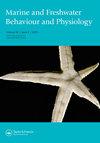鸟氨酸代谢与渗透胁迫反应
IF 1.1
4区 生物学
Q3 MARINE & FRESHWATER BIOLOGY
Marine and Freshwater Behaviour and Physiology
Pub Date : 2023-03-08
DOI:10.1080/10236244.2023.2208724
引用次数: 0
摘要
先前的转录组学研究表明,鸟氨酸脱羧酶(ODC)在Mytilus spp.)中的表达可能是渗透胁迫反应的关键组成部分。鸟氨酸通过ODC分解为多胺,或通过鸟氨酸转氨酶(OAT)分解为谷氨酸或脯氨酸。为了更好地了解鸟氨酸在低盐度条件下是如何代谢的,我们研究了三种耐盐性不同的物种(M. trossulus, M. edulis和M. galloprovincialis) OAT和ODC表达的物种特异性变化。我们发现,在低渗暴露期间,所有三个物种的ODC表达一致下降,但OAT表达明显增加。在高渗胁迫下,这些基因的表达模式发生了逆转,这表明脯氨酸或谷氨酸的合成在低盐度环境下很重要,而多胺的合成在高渗环境下可能更重要。这些反应在加洛省分枝杆菌中最为明显,在低渗暴露期间OAT增加了18倍。本文章由计算机程序翻译,如有差异,请以英文原文为准。
Ornithine metabolism and the osmotic stress response in mytilid congeners
ABSTRACT Previous transcriptomic studies have suggested that ornithine decarboxylase (ODC) expression in Mytilids (Mytilus spp.) may be a critical component of the osmotic stress response. Ornithine is catabolized into polyamines by ODC or into glutamate or proline by ornithine aminotransferase (OAT). To better understand how ornithine is metabolized under low salinity conditions, we examined species-specific variation in OAT and ODC expression for three species that vary in their salinity tolerance (M. trossulus, M. edulis, and M. galloprovincialis). We found a consistent decrease in ODC expression during hypoosmotic exposure in all three species but pronounced species-specific increases in OAT expression. During hyperosmotic stress, the patterns of expression of these genes reversed, suggesting that proline or glutamate synthesis is important during low salinity exposure, while polyamine synthesis may be more important during hyperosmotic exposure. These responses were most pronounced in M. galloprovincialis, with an 18-fold increase in OAT during hypoosmotic exposure.
求助全文
通过发布文献求助,成功后即可免费获取论文全文。
去求助
来源期刊

Marine and Freshwater Behaviour and Physiology
生物-海洋与淡水生物学
CiteScore
2.10
自引率
0.00%
发文量
9
审稿时长
>12 weeks
期刊介绍:
Marine and Freshwater Behaviour and Physiology is devoted to the publication of papers covering field and laboratory research into all aspects of the behaviour and physiology of all marine and freshwater animals within the contexts of ecology, evolution and conservation.
As the living resources of the world’s oceans, rivers and lakes are attracting increasing attention as food sources for humans and for their role in global ecology, the journal will also publish the results of research in the areas of fisheries biology and technology where the behaviour and physiology described have clear links to the contexts mentioned above.
The journal will accept for publication Research Articles, Reviews, Rapid Communications and Technical Notes (see Instructions for authors for details). In addition, Editorials, Opinions and Book Reviews (invited and suggested) will also occasionally be published. Suggestions to the Editor-In-Chief for Special Issues are encouraged and will be considered on an ad hoc basis.
With the goal of supporting early career researchers, the journal particularly invites submissions from graduate students and post-doctoral researchers. In addition to recognising the time constraints and logistical limitations their research often faces, and their particular need for a prompt review process, accepted articles by such researchers will be given prominence within the journal (see Instructions for authors for details).
 求助内容:
求助内容: 应助结果提醒方式:
应助结果提醒方式:


